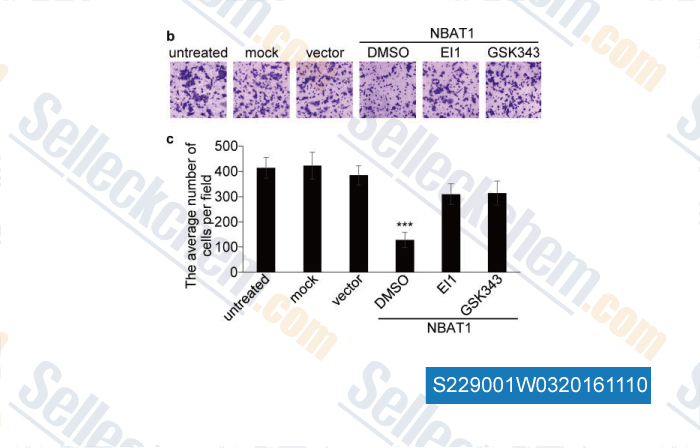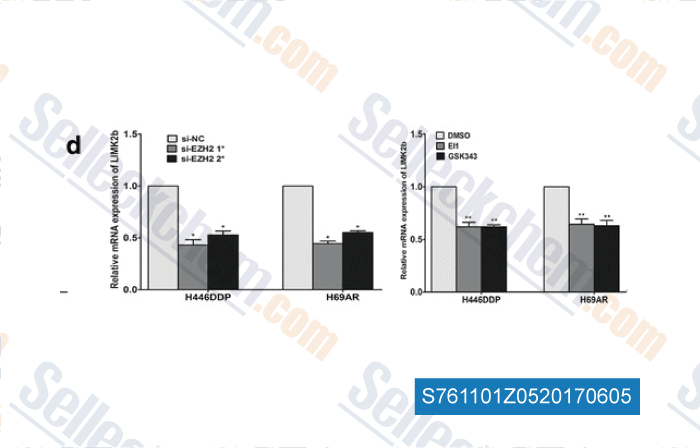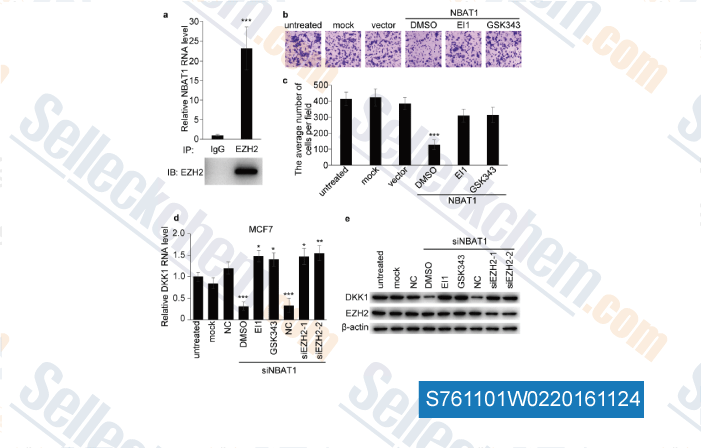|
Toll Free: (877) 796-6397 -- USA and Canada only -- |
Fax: +1-832-582-8590 Orders: +1-832-582-8158 |
Tech Support: +1-832-582-8158 Ext:3 Please provide your Order Number in the email. |
Technical Data
| Formula | C23H26N4O2 |
||||||||||||||
| Molecular Weight | 390.48 | CAS No. | 1418308-27-6 | ||||||||||||
| Solubility (25°C)* | In vitro | DMSO | 42 mg/mL (107.55 mM) | ||||||||||||
| Water | Insoluble | ||||||||||||||
| Ethanol | Insoluble | ||||||||||||||
| In vivo (Add solvents to the product individually and in order) |
|
||||||||||||||
|
* <1 mg/ml means slightly soluble or insoluble. * Please note that Selleck tests the solubility of all compounds in-house, and the actual solubility may differ slightly from published values. This is normal and is due to slight batch-to-batch variations. * Room temperature shipping (Stability testing shows this product can be shipped without any cooling measures.) |
|||||||||||||||
Preparing Stock Solutions
Biological Activity
| Description | EI1 is a potent and selective EZH2 inhibitor with IC50 of 15 nM and 13 nM for EZH2 (WT) and EZH2 (Y641F), respectively. | ||||
|---|---|---|---|---|---|
| Targets |
|
||||
| In vitro | In DLBCL cells, EI1 inhibits cellular H3K27 methylation and activates Ezh2 target gene p16 expression. In mouse embryonic fibroblasts, EI1 also inhibit H3K27me3 and cell proliferation. In addition, EI1 selectively inhibits the growth of DLBCL cells carrying Ezh2 mutation, and causes cell cycle arrest and apoptosis. [1] |
Protocol (from reference)
| Kinase Assay:[1] |
|
|---|---|
| Cell Assay:[1] |
|
References
|
Customer Product Validation

-
, , Oncotarget, 2015, 6(32):32410-25.

-
, , Mol Cancer, 2017, 16(1):5

-
Data from [ , , Oncotarget, 2015, 6(32): 32410-32425. ]
Selleck's EI1 Has Been Cited by 6 Publications
| Genetic and epigenetic characterization of sarcoma stem cells across subtypes identifies EZH2 as a therapeutic target [ NPJ Precis Oncol, 2025, 9(1):7] | PubMed: 39789291 |
| Epigenetic Reprogramming with Antisense Oligonucleotides Enhances the Effectiveness of Androgen Receptor Inhibition in Castration-Resistant Prostate Cancer [ Cancer Res, 2018, 78(20):5731-5740] | PubMed: 30135193 |
| Epigenetic drift of H3K27me3 in aging links glycolysis to healthy longevity in Drosophila [ Elife, 2018, 7e35368] | PubMed: 29809154 |
| Long non-coding RNA TUG1 is involved in cell growth and chemoresistance of small cell lung cancer by regulating LIMK2b via EZH2. [Niu Y, et al. Mol Cancer, 2017, 10.1186/s12943-016-0575-6] | PubMed: 28069000 |
| The Human Immunodeficiency Virus 1 ASP RNA promotes viral latency by recruiting the Polycomb Repressor Complex 2 and promoting nucleosome assembly. [ Virology, 2017, 506:34-44] | PubMed: 28340355 |
| NBAT1 suppresses breast cancer metastasis by regulating DKK1 via PRC2 [Hu P, et al. Oncotarget, 2015, 6(32):32410-25] | PubMed: 26378045 |
RETURN POLICY
Selleck Chemical’s Unconditional Return Policy ensures a smooth online shopping experience for our customers. If you are in any way unsatisfied with your purchase, you may return any item(s) within 7 days of receiving it. In the event of product quality issues, either protocol related or product related problems, you may return any item(s) within 365 days from the original purchase date. Please follow the instructions below when returning products.
SHIPPING AND STORAGE
Selleck products are transported at room temperature. If you receive the product at room temperature, please rest assured, the Selleck Quality Inspection Department has conducted experiments to verify that the normal temperature placement of one month will not affect the biological activity of powder products. After collecting, please store the product according to the requirements described in the datasheet. Most Selleck products are stable under the recommended conditions.
NOT FOR HUMAN, VETERINARY DIAGNOSTIC OR THERAPEUTIC USE.
